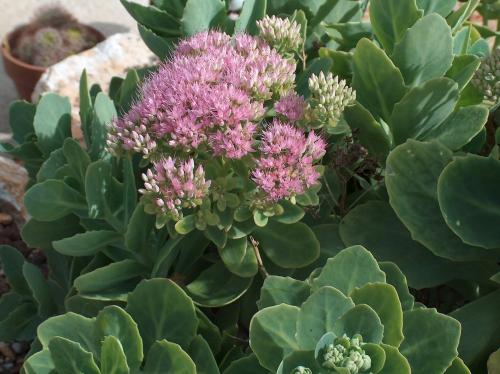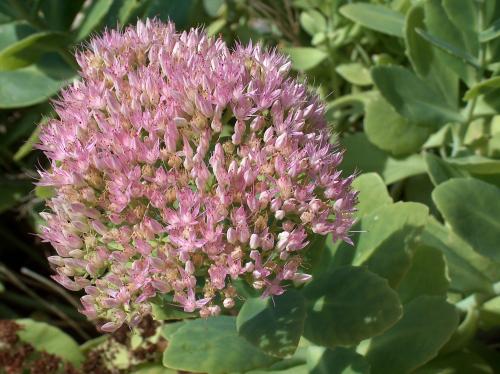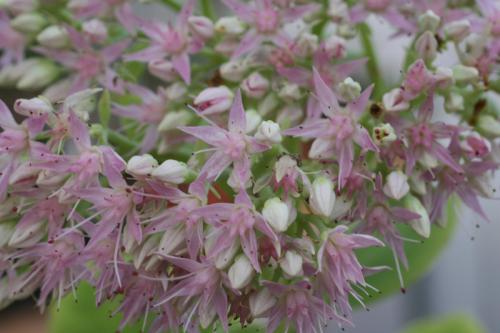SPECTABILE (Boreau) H. Ohba, 1977
Synonyms :
Sedum spectabile Boreau (1866) / Anacampseros spectabile (Boreau) Jordan & Fourreau (1867)
Sedum telephium var. kirinense Komarov (1903)
Sedum pseudospectabile Praeger (1917)
Hylotelephium pseudospectabile (Praeger) S. H. Fu (1980)
Sedum spectabile var. angustifolium Kitagawa (1936) / Hylotelephium spectabile var. angustifolium (Kitagawa) S. H. Fu (1980)
Section Hylotelephium
Distribution : North-eastern China, Korea ; flowers August to September.
Description (by H. Ohba in IHSP, 2003) :
Flowering stems erect, glaucous, greenish-white, 30 - 70 cm, with thickening rootstock and roots.
Leaves opposite or whorled, ovate to narrowly ovate, 7 - 13 x 5 - 8 cm, glaucous, tip obtuse, margins with a few undulate serrations.
Inflorescences corymb-like, large.
Flowers : Sepals lanceolate, ± 2 mm, petals pink, narrowly oblong, 6 -7 mm, stamens longer than the petals, anthers reddish-brown.
Cytology: 2n = 50.
Frequently planted in gardens in temperate climates, and increasingly also used as a cut flower. Numerous cultivars with different leaf and flower colours are marketed.
Ray Stephenson (Sedum, Cultivated Stonecrops, 1994, p 272) :
This species, known as the common ice plant of cottage gardens, is usually 45 cm (18 in) high, very light glaucous green, and a bright subject for the border. Perhaps Hylotelephium spectabile is still more common in its true form than in the plethora of cultivars now available. Large, flat-topped, pink-purple inflorescences of autumn are a great attraction to nectar-feeding insects, especially butterflies and hoverflies.
Habitat : This stonecrop is native to Korea and northern China at low altitudes.
Main points of distinction : The species could be confused with any of the other common species in Hylotelephium group (e.g., H. erythrosticum, H. telephium and its subspecies and varieties including [the hybrid] 'Autumn Joy' = 'Herbstfreude'). Exceptionally light green foliage of H. spectabile immediately separates it from all H. telephium subspecies and cultivars [/ hybrids] except 'Autumn Joy', which is similar in color. However, the latter is blue-green and generally a larger plant with huge, very dentate leaves, unlike the sparsely toothed leaves of H. spectabile (Leaf shapes, fig. 1d). The very long stamens of H. spectabile are the best identifying feature to set the species apart from other species. Flower parts of H. spectabile are generally of the same color, in contrast to H. erythrosticum with its distinctly bicolored flowers.
Variation : As this stonecrop has been in cultivation for centuries, it has many cultivated forms. The actual wild plant is usually no more than 35 cm (14 in) in height, but in developing new, deeper flower colors and a greater variety of hues, sturdier strains with double chromosomes have been developed. n = 25, and, in some cultivated forms, n = 50.
The following cultivars are commonly seen and offer alternative flower colors :
'Brilliant' is a North American cultivar that dates back to before the First World War. Its bright pink anthers and carpels are an improvement on the type species, but it often sports light colored flowers.
'Carmen' and 'Meteor' have darker, rich purple flowers.
'Rosenteller' is a European cultivar similar to 'Brilliant'
'Septemberglut', originating on mainland Europe, is perhaps the most spectacular form as it has the darkest umbels. Although the inflorescences are large, individual flowers are slighly smaller than those of the other cultivars.
'Snow Queen' and 'Stardust' have white flowers.
Vegetatively, cultivars appear to be quite similar to the true species. In a well-manured border, tall spectacular plants can be grown, but the same clones confined to clay pots are pallid and stunted, though still pleasing.
Horticulture : Division of the rootstock is the usual method of propagation, though cuttings in spring will also grow. Avoid peat-based composts at all costs. The plants themselves do not dislike this medium, but peat attracts and harbors their most harmful enemies.
Plant in cultivation (30 / 8 / 2009)


